Tuesday, 5 July 2016, Exploring Heraklion
Written 7 July 2016

 After breakfast as usual at the hotel, I started the day with a little travel-diary blog touching up, then took a long walk through the old town and the market. I bought a few postcards (to keep rather than to send), but I resisted a tempting Cretan cookbook.
After breakfast as usual at the hotel, I started the day with a little travel-diary blog touching up, then took a long walk through the old town and the market. I bought a few postcards (to keep rather than to send), but I resisted a tempting Cretan cookbook.
The very first thing I came to, just a block behind our hotel, was this area of ruins that are actually under the archeological museum. They're fenced off from pedestrian traffic, but you can look right down into them from the sidewalk.
Beside the sidewalk along the side of the museum was a planting of little pomegranate trees. The trees were small, but they were clearly growing full-size pomegranates!
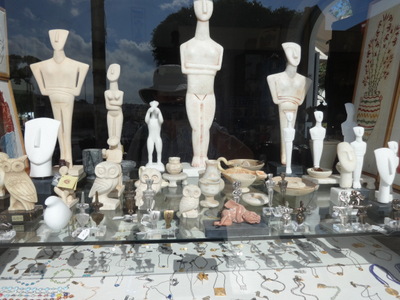
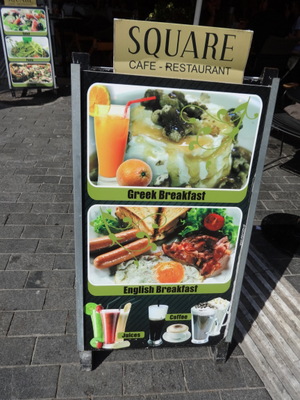 In Liberty Square, which is directly in front of the museum, gift shops were offering all sorts of statuettes and other replicas of objects in the museum. I was tempted by some of the smaller
ones, but I found them rather overpriced.
In Liberty Square, which is directly in front of the museum, gift shops were offering all sorts of statuettes and other replicas of objects in the museum. I was tempted by some of the smaller
ones, but I found them rather overpriced.
I passed this sign in front of a restaurant, advertising "Greek breakfast" and "English breakfast." The latter featured eggs, bacon, sausage, and toast, garnished with lettuce and tomato. The former seemed to be a tall glass of orange juice, and a cylindrical white cheese with honey poured over it and topped with something I didn't recognize (stuffed grape leaves? olives? No clue.
Signs with photos of the food are particularly helpful in a country where I can't even decipher the alphabet in real time, let alone translate the words, though I have mixed feelings, since depending on photos of the food is in conflict with my usual preference for avoiding places that too obviously cater to tourists.
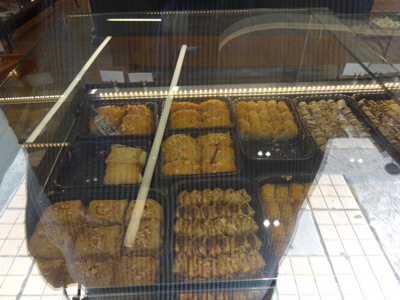
 Even more tempting than the souvenirs were the pastry-shop windows.
Even more tempting than the souvenirs were the pastry-shop windows.
At the left are many kinds of what we generally think of as "Greek" pastries, mostly layered or wrapped with phyllo or kataifi, filled with nuts or custard, and doused with honey or syrup.
At the right are more "French" style ones—macaroons, truffles, tartlets, and little decorated squares of cake.
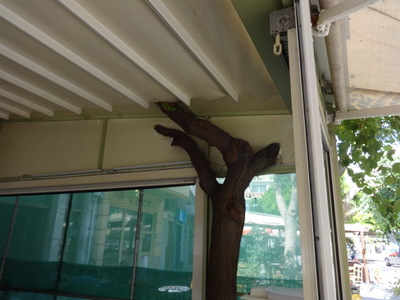
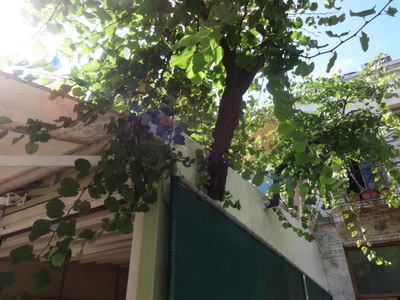 In passing a café, I was struck by the accommodation the establishment had made to the conflict between its sidewalk enclosure and a nearby tree.
In passing a café, I was struck by the accommodation the establishment had made to the conflict between its sidewalk enclosure and a nearby tree.
The tree is actually growing inside the enclosure, but where it reaches the ceiling and side wall, it has been permitted to grow right through; the building material is filled in around it.
Its three branches reemerge outdoors and spread at will in the open air. I think it's a Bauhinia; if so, it should bear large, beautiful orchid-like blossoms in season.
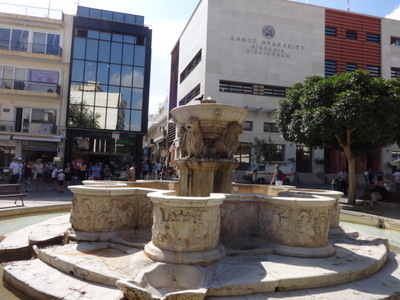
 At the left here is the Morosini Fountain, pretty clearly from Heraklion's Venetian period (Morosoni designed and perhaps built it). Folks from the conference give each other directions from it to restaurants, shops, etc. and just refer to the large open intersection it dominates (formally Morosini Square") as "lion square."
At the left here is the Morosini Fountain, pretty clearly from Heraklion's Venetian period (Morosoni designed and perhaps built it). Folks from the conference give each other directions from it to restaurants, shops, etc. and just refer to the large open intersection it dominates (formally Morosini Square") as "lion square."
I was in a shop about a block from it, buying my postcards and looking over the English-language Cretan cookbooks, when a guy came in and asked, in accented English, how to find the market. "The market!," I thought, "I'm going to follow this guy!" The directions turned out to be simple: "Go that way; take the first right." I accordingly fell in behind the guy and his party of six or so (speaking a language I didn't recognize; something Scandinavian maybe), and sure enough. The right turn actually put us in the market, a narrow pedestrian street (officially 1866 Street, commemorating some battle) thickly lined with shows and sidewalk vendors.
One of the commonest displays, particularly at the near—and therefore more touristy—end of the market, is a large array of culinary herbs. The packages of single herbs were mostly well known types—sage, rosemary, thyme, oregano, hot peppers—but two that were especially prominently featured were "mountain tea" (perhaps the stuff David had at Eleftherna; Sideritis syriaca, in the mint family) and "dittany" (both a tea and a dressing for wounds; Origanum dictamnus," in the same genus as oregano). The proprietor assured me dittany could only be grown on Crete.
But then came the packages labeled "mixture for . . .," ready-made blends intended for preparation of, e.g., barbecue (red and white), burgers, salad, fish, pitsa (pizza) sauce, mousaka, lamp (lamb), stewed meat, vegetables, pork, "spaggeti," gyros/souvlaki, potatoes, tsatziki, chicken, and feta cheese.

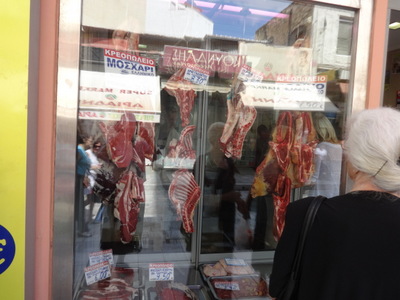 The herbs were all labeled in Greek and English (sometimes French and German), but when it came to the poultry and meat, it was strictly Greek only.
The herbs were all labeled in Greek and English (sometimes French and German), but when it came to the poultry and meat, it was strictly Greek only.
I think this is all chicken, just cut up in different says, and perhaps raised differently, as some is much yellower than the rest.
Many of the butcher shops displayed their meat in the same sort of cases we would see in the U.S. (although not prepackaged under plastic), but I liked this display, where the lamb quarters hung on hooks in the window.
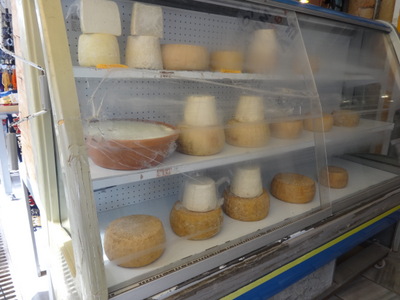
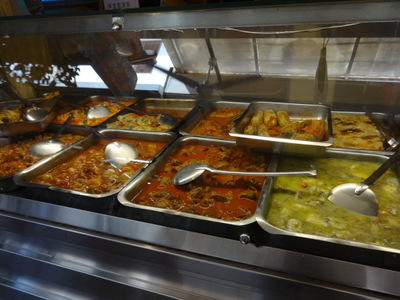 Three or four shops were selling cheese, some just two or three kinds (probably that they made themselves) and others a wider assortment, commercially labeled.
Three or four shops were selling cheese, some just two or three kinds (probably that they made themselves) and others a wider assortment, commercially labeled.
A few shops offered ready-made hot food for take-out, in this case, entirely unlabeled.
I found a small cluster of coffee roasters, selling beans packaged and in bulk, all freshly roasted—boy did that little area smell delicious!
I even found a little restaurant whose sign seemed to say that it served roast suckling pig, but it was not yet open for the day.
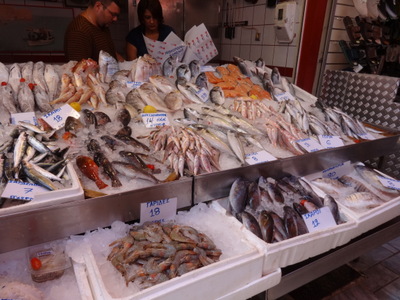
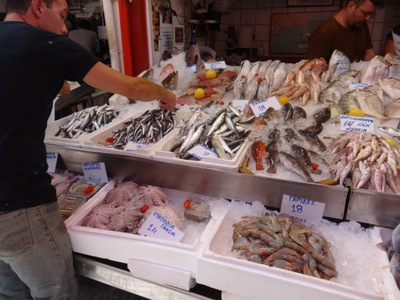 A short side street was lined with fish displays, almost odorless so fresh was the merchandise. The labeling was all in Greek, but I could recognize some species and sound out others from the Greek alphabet. I was surprised to see parrotfish (the stubby little bright red guy and his dark-colored companions, just behind the prawns in the bottom row) at several stalls—I had not thought of them as a Mediterranean kind of thing. A few fishes that weren't Mediterranean were offered, in particular the bright orange salmon steaks you can see at the upper right of the left-hand photo.
A short side street was lined with fish displays, almost odorless so fresh was the merchandise. The labeling was all in Greek, but I could recognize some species and sound out others from the Greek alphabet. I was surprised to see parrotfish (the stubby little bright red guy and his dark-colored companions, just behind the prawns in the bottom row) at several stalls—I had not thought of them as a Mediterranean kind of thing. A few fishes that weren't Mediterranean were offered, in particular the bright orange salmon steaks you can see at the upper right of the left-hand photo.
The right-hand photo is a different view of the same display, which was a particularly attractive one. Note the octopus in the lower left corner and the big tuna steaks (decorated with two lemons) at the top left.
Aside from these prawns and octopus and a few cuttlefish, the only other shellfish I saw were at a stall that was displaying one small sack each of mussels, oysters, and three different clam-like bivalves. Oh, and one sack of snails.
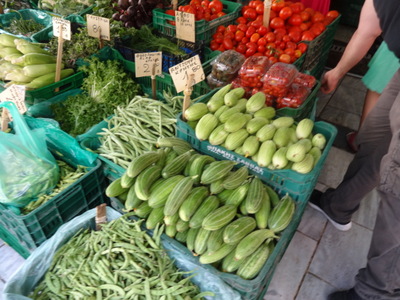
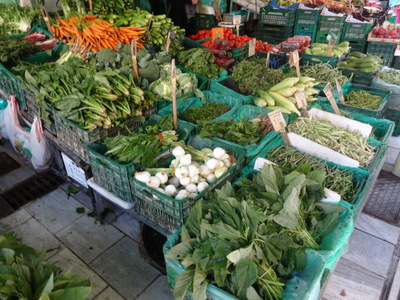 Of course, vegetables were also present: cucumbers, zucchini, zucchini flowers (with and without attached tiny zucchinis), tomatoes, string beans (both round and flat), lettuce, corn, eggplant, beets, fennel, purslane (Portulaca sp.), cauliflower, carrots, cabbages, peppers, onions, chard, spinach, and some green that I didn't recognize.
Of course, vegetables were also present: cucumbers, zucchini, zucchini flowers (with and without attached tiny zucchinis), tomatoes, string beans (both round and flat), lettuce, corn, eggplant, beets, fennel, purslane (Portulaca sp.), cauliflower, carrots, cabbages, peppers, onions, chard, spinach, and some green that I didn't recognize.
Although lettuce was present, it was nowhere near as prominent as it would have been in France or even the U.S., since salads here often omit it entirely.

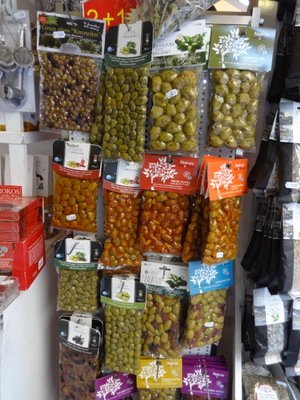 I saw one bakery, but these breads were being sold in a souvenir shop, labeled "wedding bread." I suspect they're not actually edible, although edible ones may be produced for real weddings.
I saw one bakery, but these breads were being sold in a souvenir shop, labeled "wedding bread." I suspect they're not actually edible, although edible ones may be produced for real weddings.
Another very common display was whole walls of these olives, vaccuum packed in heavy plastic pouches. I recognized variety names from a tour of an olive farm in Georgia (organized by Westminster Oaks), and they came marinated in (olive oil and) all sorts of things: mostly rosemary, oregano, red chilis, and garlic and chilis, as well as plain and in mixtures of varieties and colors.
And finally, everywhere, rusks. They seem to be sold in 1-, 2-, and 3-gallon bags (and even larger ones in the supermarkets). Popular, I'd say.
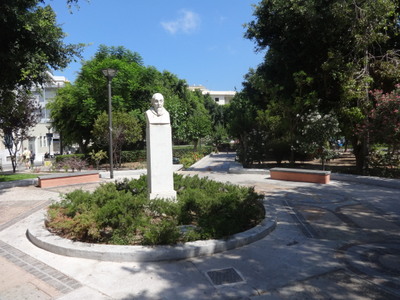
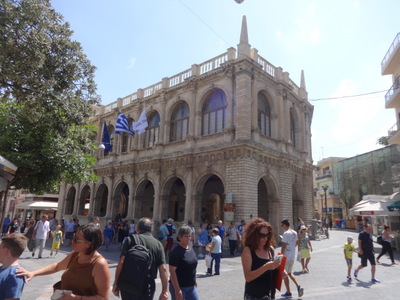 From the market, I made a leisurely loop back toward the hotel and en route, I came across this statue of El Greco. He's thought of as a Spanish painter, but he was called "El Greco," the Greek, because he was from Greece, specifically Heraklion. His real name was Doménikos Theotokópoulos. The house where he was born is here somewhere, but I haven't sought it out. This lovely park is named for him.
From the market, I made a leisurely loop back toward the hotel and en route, I came across this statue of El Greco. He's thought of as a Spanish painter, but he was called "El Greco," the Greek, because he was from Greece, specifically Heraklion. His real name was Doménikos Theotokópoulos. The house where he was born is here somewhere, but I haven't sought it out. This lovely park is named for him.
I also came upon the "Venetian loggia," now Heraklion's city hall. In this view, it looks rather small and almost hollow, but behind what looks like the back wall here is a large, more solid section with a curved outside wall.
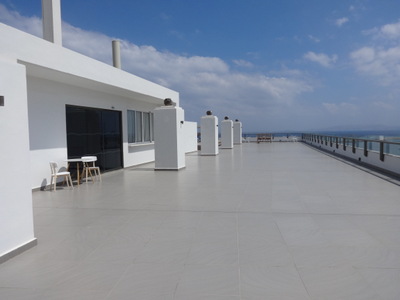
 I got back to the hotel with a little time left before lunch, so I took a minute to explore the fabled sixth floor, where (earlier in the meeting) free massages were offered to all participants. I found that you step out of the dim elevator directly into this blinding expanse of sun-baked tile!
I got back to the hotel with a little time left before lunch, so I took a minute to explore the fabled sixth floor, where (earlier in the meeting) free massages were offered to all participants. I found that you step out of the dim elevator directly into this blinding expanse of sun-baked tile!
The black glass doors lead to the "spa," where the masseuse lurks. Otherwise, all you find is space, spectacular views over the city, and the pool, shown in the right-hand photo. It was desserted except for the 13-year-old daughter of one of the meeting participants, lounging in the shade of one of the pillars reading a novel.
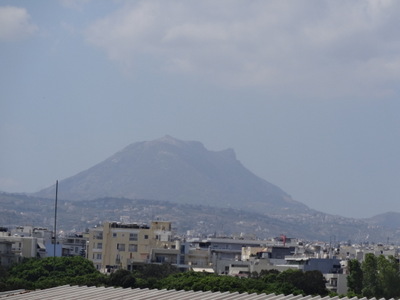
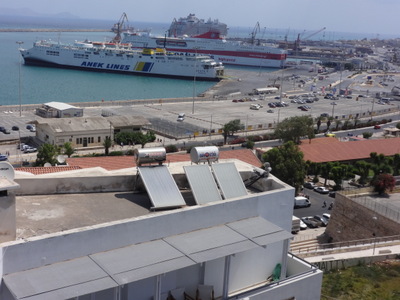 I'm pretty sure this mountain is Mt. Ida (slightly telephotoed). Tomorrow's full-day excursion will take us in that direction.
I'm pretty sure this mountain is Mt. Ida (slightly telephotoed). Tomorrow's full-day excursion will take us in that direction.
The shot at the right shows interisland ferries lined up at the less-historic side of the harbor, but I took it mainly to show a phenomenon I've seen everywhere here—horizontal cylindrical tanks atop slanted flat panels. I'm almost sure they're solar hot-water heaters! The flat panels are always facing south and must be solar cells. They are everywhere in both the city and the countryside on public buildings and private homes. Good idea here, where, at least in the summer, the sunshine is relentless. I'm told it rains in the winter.

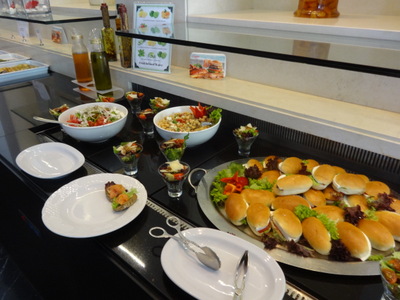 Lunch was on the same pattern are Monday's, but with different choices. Of course, the ubiquitous dakos service led off. Then came the same chicken wraps as yesterday, but the bruschetta had changed from prosciutto to excellent smoked salmon. The little parfait glasses hold individual green salads topped with Parmesan slivers and balsamic vinaigrette.
Lunch was on the same pattern are Monday's, but with different choices. Of course, the ubiquitous dakos service led off. Then came the same chicken wraps as yesterday, but the bruschetta had changed from prosciutto to excellent smoked salmon. The little parfait glasses hold individual green salads topped with Parmesan slivers and balsamic vinaigrette.
Next were little oval sandwiches of white cheese and tomato, Greek salad, and marinated chick-pea salad.
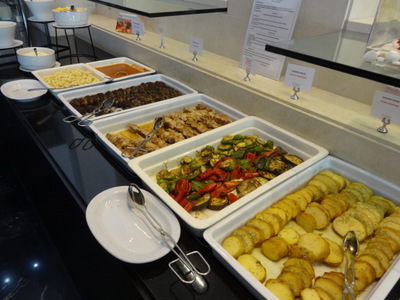
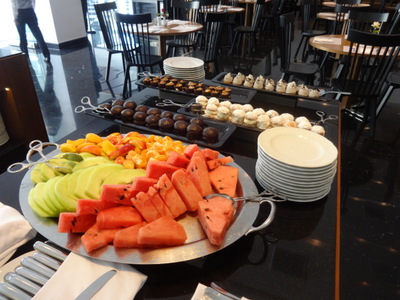 Farther along were platters of sliced baked potato. grilled vegetables, grilled chicken skewers, minature grilled "burgers," and tortellini with tomato sauce. They do a lot of grilling here and are very good at it. Even the bacon at breakfast has grill marks on it.
Farther along were platters of sliced baked potato. grilled vegetables, grilled chicken skewers, minature grilled "burgers," and tortellini with tomato sauce. They do a lot of grilling here and are very good at it. Even the bacon at breakfast has grill marks on it.
Individual pastry items on the dessert table come and go, but we always find several kinds, plus the fruit platter.
The pastry assortment for coffee breaks is the same way—same pattern every day, but a few substituted items. Today, they offered miniature kalitsounias, the little cheesecake tarts we had at the icebreaker reception.
I worked on the travel diary and goofed off until the afternoon coffee break, then attended the 4 p.m. cultural talk about the Phaistos (for Faistos or Festos) disk. It's a 4000-year-old clay disk, a little bigger than a large hamburger, with inscriptions on both sides. The inscription is arranged in a spiral (from the inside out, I think, but maybe the other way around), is made up of what are thought to be a syllabary of pictograms, and has never been deciphered. It was found in the king's palace at Phaistos/Faistos/Festos, which we will visit tomorrow. It's unusual for several reasons. First, it was deliberately fired to make a permanent object, whereas almost all writing of the time was temporary and practical—lists of commercial transations, etc.—and was rubbed out after use so that the clay tablet could be reused. The only reason we have any such writing is that occasionally the tablets were accidentally baked in, e.g., a house fire. Second, the pictograms were not hand drawn; each one was stamped into the clay with a tool made for the purpose, so every occurrence of the same pictogram is identical to the others. As the lecturer pointed out, you don't go to the trouble of making such implements unless you plan to use them repeatedly. Third, only one has ever been found, even though it seems to have been semi-mass-produced, and nothing else uses the same pictograms. The lecturer thinks he's found three occurrences on it of a name meaning "pregnant goddess" (= Astarte, maybe?) and, because of periodic repeats in the text, that it might have been two songs, one on each side, and maybe even for use by women giving childbirth or those assisting them.
The logo of the meiofauna congress is a parody of the disk, with little meiofauna images subsituted for the pictograms—cute.
After that, we spent some time at the evening poster session but resisted the food (too bad, more salmon canapes) and went back to Kastella for dinner with friends Julian Smith and his wife Diane Rudulph.
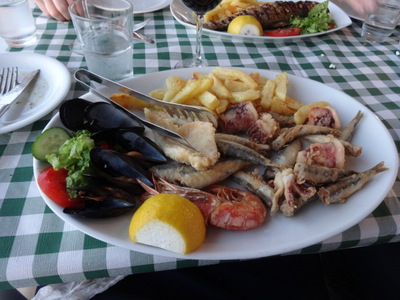 Except for me, everybody ordered grilled whole sea bass again. I went for what they call "mixed fish," and I got half a dozen steamed mussels in the shell, a triangle of fried white fish (under the jaws of the tongs), a couple of squid (or maybe cuttlefish) cut up and fried, a large prawn, and a heap of little fried whole (well, headless) anchovies, all accompanied by token salad and a pile of fries. Yummy, indeed.
Except for me, everybody ordered grilled whole sea bass again. I went for what they call "mixed fish," and I got half a dozen steamed mussels in the shell, a triangle of fried white fish (under the jaws of the tongs), a couple of squid (or maybe cuttlefish) cut up and fried, a large prawn, and a heap of little fried whole (well, headless) anchovies, all accompanied by token salad and a pile of fries. Yummy, indeed.
We are told by colleagues who follow such things that Kastella is #1 restaurant on trip advisor for Heraklion and that Peskesi, where we plan to go tomorrow is #2.
Unfortunately, at bedtime, David discovered that his pillow, his very own personal pillow, which he always travels with, had disappeared from the room. After much negotiation with the hotel management, the current hypothesis is that it got tangled up in the sheets and sent off to the laundry. The laundry has come back twice since then, but no pillow. The hotel has located a pillow conforming to his specifications, and if his doesn't turn up, he's going to insist they give it to him to keep.
Meanwhile, the maid (presumably the same one) has confiscated one of the empty water bottles I was saving (good thing I left some water in the other, or she'd have taken that, too) and has indicated on the little checklist supplied for the purpose that I took a coke from the minibar, which I didn't. I'd say the housekeeping staff are losing brownie points fairly quickly.
Previous entry
List of Entries
Next entry

 After breakfast as usual at the hotel, I started the day with a little travel-diary blog touching up, then took a long walk through the old town and the market. I bought a few postcards (to keep rather than to send), but I resisted a tempting Cretan cookbook.
After breakfast as usual at the hotel, I started the day with a little travel-diary blog touching up, then took a long walk through the old town and the market. I bought a few postcards (to keep rather than to send), but I resisted a tempting Cretan cookbook.
 In Liberty Square, which is directly in front of the museum, gift shops were offering all sorts of statuettes and other replicas of objects in the museum. I was tempted by some of the smaller
ones, but I found them rather overpriced.
In Liberty Square, which is directly in front of the museum, gift shops were offering all sorts of statuettes and other replicas of objects in the museum. I was tempted by some of the smaller
ones, but I found them rather overpriced.
 Even more tempting than the souvenirs were the pastry-shop windows.
Even more tempting than the souvenirs were the pastry-shop windows.
 In passing a café, I was struck by the accommodation the establishment had made to the conflict between its sidewalk enclosure and a nearby tree.
In passing a café, I was struck by the accommodation the establishment had made to the conflict between its sidewalk enclosure and a nearby tree. 
 At the left here is the Morosini Fountain, pretty clearly from Heraklion's Venetian period (Morosoni designed and perhaps built it). Folks from the conference give each other directions from it to restaurants, shops, etc. and just refer to the large open intersection it dominates (formally Morosini Square") as "lion square."
At the left here is the Morosini Fountain, pretty clearly from Heraklion's Venetian period (Morosoni designed and perhaps built it). Folks from the conference give each other directions from it to restaurants, shops, etc. and just refer to the large open intersection it dominates (formally Morosini Square") as "lion square."
 The herbs were all labeled in Greek and English (sometimes French and German), but when it came to the poultry and meat, it was strictly Greek only.
The herbs were all labeled in Greek and English (sometimes French and German), but when it came to the poultry and meat, it was strictly Greek only.
 Three or four shops were selling cheese, some just two or three kinds (probably that they made themselves) and others a wider assortment, commercially labeled.
Three or four shops were selling cheese, some just two or three kinds (probably that they made themselves) and others a wider assortment, commercially labeled.
 A short side street was lined with fish displays, almost odorless so fresh was the merchandise. The labeling was all in Greek, but I could recognize some species and sound out others from the Greek alphabet. I was surprised to see parrotfish (the stubby little bright red guy and his dark-colored companions, just behind the prawns in the bottom row) at several stalls—I had not thought of them as a Mediterranean kind of thing. A few fishes that weren't Mediterranean were offered, in particular the bright orange salmon steaks you can see at the upper right of the left-hand photo.
A short side street was lined with fish displays, almost odorless so fresh was the merchandise. The labeling was all in Greek, but I could recognize some species and sound out others from the Greek alphabet. I was surprised to see parrotfish (the stubby little bright red guy and his dark-colored companions, just behind the prawns in the bottom row) at several stalls—I had not thought of them as a Mediterranean kind of thing. A few fishes that weren't Mediterranean were offered, in particular the bright orange salmon steaks you can see at the upper right of the left-hand photo.
 Of course, vegetables were also present: cucumbers, zucchini, zucchini flowers (with and without attached tiny zucchinis), tomatoes, string beans (both round and flat), lettuce, corn, eggplant, beets, fennel, purslane (Portulaca sp.), cauliflower, carrots, cabbages, peppers, onions, chard, spinach, and some green that I didn't recognize.
Of course, vegetables were also present: cucumbers, zucchini, zucchini flowers (with and without attached tiny zucchinis), tomatoes, string beans (both round and flat), lettuce, corn, eggplant, beets, fennel, purslane (Portulaca sp.), cauliflower, carrots, cabbages, peppers, onions, chard, spinach, and some green that I didn't recognize. 
 I saw one bakery, but these breads were being sold in a souvenir shop, labeled "wedding bread." I suspect they're not actually edible, although edible ones may be produced for real weddings.
I saw one bakery, but these breads were being sold in a souvenir shop, labeled "wedding bread." I suspect they're not actually edible, although edible ones may be produced for real weddings.
 From the market, I made a leisurely loop back toward the hotel and en route, I came across this statue of El Greco. He's thought of as a Spanish painter, but he was called "El Greco," the Greek, because he was from Greece, specifically Heraklion. His real name was Doménikos Theotokópoulos. The house where he was born is here somewhere, but I haven't sought it out. This lovely park is named for him.
From the market, I made a leisurely loop back toward the hotel and en route, I came across this statue of El Greco. He's thought of as a Spanish painter, but he was called "El Greco," the Greek, because he was from Greece, specifically Heraklion. His real name was Doménikos Theotokópoulos. The house where he was born is here somewhere, but I haven't sought it out. This lovely park is named for him.
 I got back to the hotel with a little time left before lunch, so I took a minute to explore the fabled sixth floor, where (earlier in the meeting) free massages were offered to all participants. I found that you step out of the dim elevator directly into this blinding expanse of sun-baked tile!
I got back to the hotel with a little time left before lunch, so I took a minute to explore the fabled sixth floor, where (earlier in the meeting) free massages were offered to all participants. I found that you step out of the dim elevator directly into this blinding expanse of sun-baked tile!
 I'm pretty sure this mountain is Mt. Ida (slightly telephotoed). Tomorrow's full-day excursion will take us in that direction.
I'm pretty sure this mountain is Mt. Ida (slightly telephotoed). Tomorrow's full-day excursion will take us in that direction.
 Lunch was on the same pattern are Monday's, but with different choices. Of course, the ubiquitous dakos service led off. Then came the same chicken wraps as yesterday, but the bruschetta had changed from prosciutto to excellent smoked salmon. The little parfait glasses hold individual green salads topped with Parmesan slivers and balsamic vinaigrette.
Lunch was on the same pattern are Monday's, but with different choices. Of course, the ubiquitous dakos service led off. Then came the same chicken wraps as yesterday, but the bruschetta had changed from prosciutto to excellent smoked salmon. The little parfait glasses hold individual green salads topped with Parmesan slivers and balsamic vinaigrette.
 Farther along were platters of sliced baked potato. grilled vegetables, grilled chicken skewers, minature grilled "burgers," and tortellini with tomato sauce. They do a lot of grilling here and are very good at it. Even the bacon at breakfast has grill marks on it.
Farther along were platters of sliced baked potato. grilled vegetables, grilled chicken skewers, minature grilled "burgers," and tortellini with tomato sauce. They do a lot of grilling here and are very good at it. Even the bacon at breakfast has grill marks on it. Except for me, everybody ordered grilled whole sea bass again. I went for what they call "mixed fish," and I got half a dozen steamed mussels in the shell, a triangle of fried white fish (under the jaws of the tongs), a couple of squid (or maybe cuttlefish) cut up and fried, a large prawn, and a heap of little fried whole (well, headless) anchovies, all accompanied by token salad and a pile of fries. Yummy, indeed.
Except for me, everybody ordered grilled whole sea bass again. I went for what they call "mixed fish," and I got half a dozen steamed mussels in the shell, a triangle of fried white fish (under the jaws of the tongs), a couple of squid (or maybe cuttlefish) cut up and fried, a large prawn, and a heap of little fried whole (well, headless) anchovies, all accompanied by token salad and a pile of fries. Yummy, indeed.